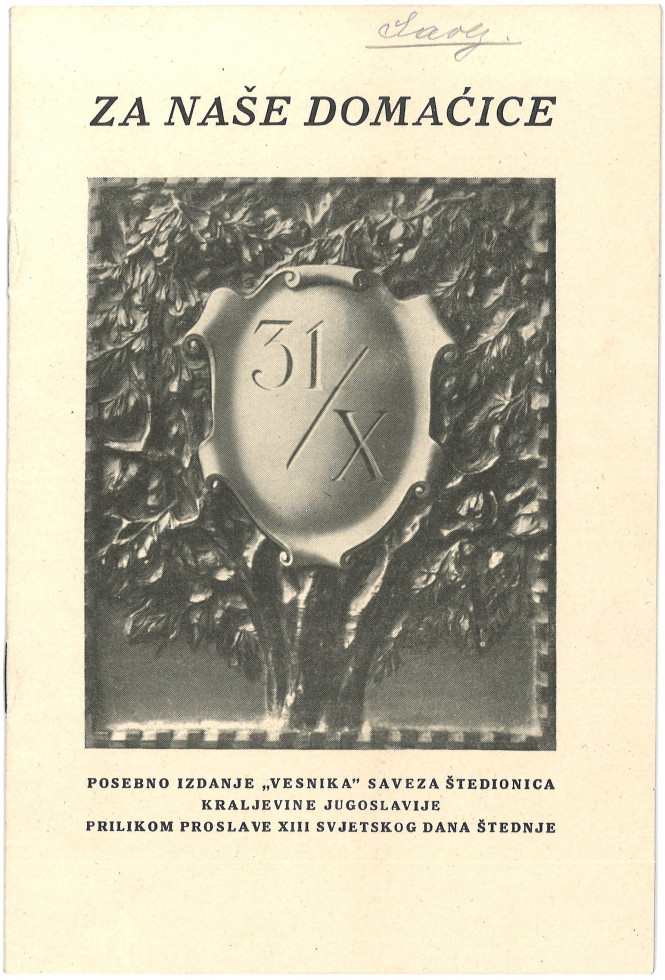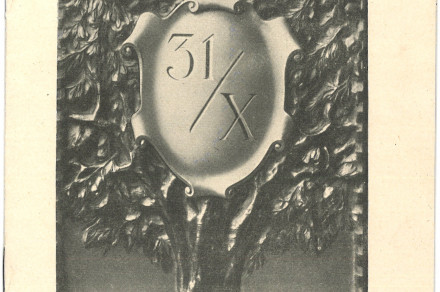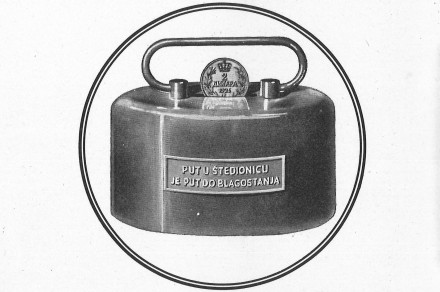Saving, the Main Principle of a Good Housewife
Zagreb, 1937
Print, 20 pages
Reference code: SI AS 437, Hranilnica Dravske banovine, box 32, folder I/3/e
Brochure »For Our Housewives«
Preserved by the Archives of the Republic of Slovenia in its archival fonds SI AS 437 are the records of the Drava Banovina Savings Bank, which is the oldest Slovenian financial institution. In 1820, a group of enterprising citizens founded the Ljubljana Savings Bank with the intent to »enable the less well-off to invest and gradually multiply their savings, thus promoting diligence and economy among the citizens.«. At first, the bank operated as a society from the room of one of its members, who all worked as volunteers for the first five years of the savings bank's existence. Its first president was the mayor Hradecky. Following the 1844 adopting of the savings banks regulation, the bank operated as a regulatory savings bank, changing its name from Illyrian Savings Bank (a name it bore since 1828) to Carniolan Savings Bank in 1845. In 1927, it was taken over by the Ljubljana Oblast Board and began operating as a public institution. As the successor of the Ljubljana Oblast Board, the Banovina again changed its name to Drava Banovina Savings Bank, Ljubljana. According to the words of the bank's management, uttered at the celebration of its 10th anniversary, the changing of the bank's status coupled with the onset of the economic crisis in 1931, halted the bank's growth but not its consolidation. As early as the next year, all the write-offs of the old bank were completed without the need to liquidate assets. It survived the bank run of worried savers, the drop of securities and the debt moratorium for farmers, and in 1935 saw the increase in their deposits, gradually rising until the deposits were higher than they had been before the onset of the economic crisis.
In the interwar period, the Drava Banovina Savings Bank was the second largest regulatory savings bank in the Slovenian territory, coming just behind the Ljubljana Municipal Savings Bank and before the Maribor Municipal Savings Bank. All three of them had almost equalled the banks in stature. It is important to distinguish the regulatory savings banks (in Slovenia in 1937, there were 28 such banovina, city, municipal and district savings banks) from numerous interwar savings and loan banks of the Slovenian cooperative loan societies, whose legal foundation was the 1873 cooperatives act, and which reached their peak of success in the second half of the 1920s with their powerful network of almost 500 cooperative societies. Regulatory savings banks organized themselves into a voluntary Union (of self-governing) savings banks soon after the First World War, and Drava Banovina Savings Bank was one of its members.
In 1935, the Managing Board of the Union of the Savings Banks of the Kingdom of Yugoslavia noted an improvement in the overall economic conditions, especially in 1936, when the harvest was poor globally but good at home and there was a decrease in supply and increase in prices, employment and purchasing power. Also, there was improvement in the economic relations with foreign nations and in state finances and there was a sense of greater certainty, albeit with an undertone of fear about the new war. Savings banks knew they had to put in considerable effort to survive the economic crisis and that their situation was not made easier by the state policies that channelled state aid only through state banks. They were of the opinion that in order to cover the huge national debt, they needed to rely on their own resources – not only on state financial institutions, but also on self-governing institutions, like savings banks.
Savings banks, supported by their union, initiated a propaganda campaign to foster the spirit of saving in citizens. Their union, although operating as a voluntary private organization, focused mainly on publications in its newsletter “Vestnik”, on managing the business of the Union of Slavic Savings Banks (including their support for the compiling of the Slavic savings dictionary), on cooperation with the International Institute of Saving, and on gathering and compiling of state statistics regarding saving. It also awarded the best articles on saving, it held educational exhibitions and encouraged its members to hold lectures in schools, on radio stations and at various events, especially on the World Savings Day, and to spread propaganda material and contribute their articles to be published in newspapers. In September 1937, the Union sent a circular to all its self-governing savings banks in the Kingdom of Yugoslavia, offering large announcements, a brochure for housewives, schedules with saving boxes, leaflets, vignettes and the memorandum of the Union’s 1st congress. The mentioned “saving” brochure for housewives has been preserved among the archival records of the Drava Banovina Savings Bank and has been selected as this month’s archivalia, since January is usually the month when the holiday glow starts to fade and a more sombre reality returns; perhaps its ideas may serve as an inspiration to us all.
The brochure titled “For Our Housewives”, published in the newsletter “Vestnik”, which was the official newsletter of the Savings Banks Union, comprises articles by three capable leaders of their households, which were considered core economic cells of the state economy (in a span of 20 years, a housewife has done 75,000 hours of work). The Union sold it to self-governing savings banks for one dinar per copy so that they could distribute the copies or otherwise use them in celebration of the 13th World Savings Day on October 31, 1937. In the spirit of the time, when the Kingdom of Yugoslavia was dealing with the Croatian question, aiming to calm national tensions and get closer to the reader, all three articles were published as they had been written by their three authors – each in her own language (for the transcript of the article in the Cyrillic alphabet, click here). The resourceful ladies Štefanija Bernas from Zagreb, Višeslava M. Đuričić from Belgrade and Amalija Izgoršek from Kranj all come from bourgeois, financially well-off backgrounds. Although their discoveries are similar, it is their writing styles that revel their personalities and origins. In addition to focusing on bourgeois upper and middle class, they pay some attention also to poorer urban and rural women, especially Višeslava, who whole-heartily stresses the significance of the women’s charitable society the Circle of Serbian Sisters.
Household management is defined as the management on which family and national prosperity depends. The basic condition for such household management is good organization of work, employing yearly, monthly and daily work plans and task schedules. If one fails to do this, then success can never be achieved, despite putting in a whole day of work. All three authors stress the social importance of innate and acquired virtues of thrift, clear thinking, thoughtfulness, engagement, diligence, tidiness, precision, neatness, compassion and philanthropy. They explain how one can avoid servitude and exhaustion that leaves a mark on one’s body and soul, whereas smart effort and savings bring personal and family satisfaction, which children then absorb. They give guidance on how to shop for seasonal food and clothing, how to run household accounts by balancing the books and setting aside extra money and investments for children’s education and for their own financially secure old age. Readers find themselves in their well-kept kitchens and pantries, where nothing ever goes to waste and every single surplus supply is donated to those in need. They discourage indulgence in unhealthy abundance, which one can overcome by having a loving attitude, artistry and creativity. They teach elegance and the art of tasteful dressing by choosing quality materials, respecting local craftsmanship and European fashion-inspired folk art. To promote saving between the two wars, when there seemed to be no end in sight to the crisis, all three authors, in a sincere effort to help, stress the importance of the most basic areas of human existence – food and drink, wardrobe, make-up and home furnishing. By reading about the possibilities of coping with one’s own strength, abilities and wisdom, the reader becomes aware of his or her own strength and abilities and of the riches inherent in them. The goal is thus achieved – see for yourself by reading the brochure.
Aleksandra Mrdavšič
- SI AS 437, Hranilnica Dravske banovine, box 32, 38.
- Lazarević, Žarko: Denarništvo: hranilnice, zadruge, banke, zavarovalnice. In: Slovenska novejša zgodovina : Od programa Zedinjena Slovenija do mednarodnega priznanja Republike Slovenije: 1848−1992, zv. 1. (ur. Jasna Fischer, idr.). Ljubljana: Mladinska knjiga, 2005, pp. 460–466.
- Murko, Vladimir in Simončič, Ivan: Hranilništvo. In: Enciklopedija Slovenije, vol. 4 (ed. Marjan Javornik). Ljubljana: Mladinska knjiga, 1990, pp. 45–47.
- Potočnik, Drago: Slovensko denarništvo 1918−1938. In: Spominski zbornik Slovenije: ob dvajsetletnici Kraljevine Jugoslavije (ed. Jože Lavrič, idr.). Ljubljana: Jubilej, 1939, pp. 444–457.
- Bankarium: Muzej bančništva Slovenije: Prva moderna institucija na Slovenskem.




